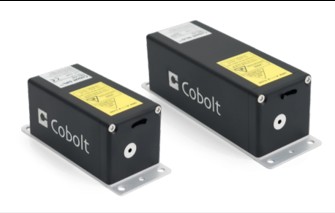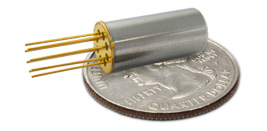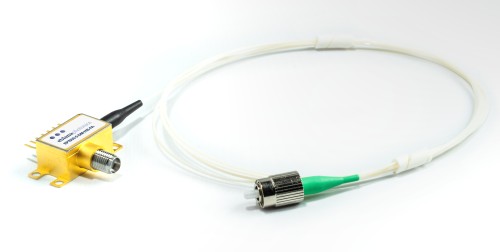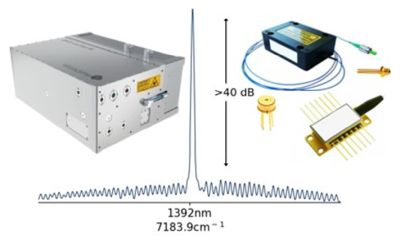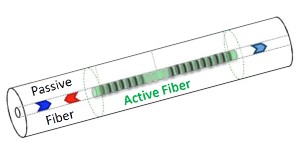narrow-linewidth lasers (original) (raw)
Definition: single-frequency lasers with a narrow optical emission spectrum
Categories:  laser devices and laser physics,
laser devices and laser physics,  fluctuations and noise
fluctuations and noise
- light sources
- lasers
* solid-state lasers
* diode-pumped lasers
* lamp-pumped lasers
* distributed feedback lasers
* dye lasers
* gas lasers
* free-electron lasers
* radiation-balanced lasers
* cryogenic lasers
* visible lasers
* eye-safe lasers
* infrared lasers
* ultraviolet lasers
* X-ray lasers
* upconversion lasers
* Raman lasers
* high-power lasers
* multi-line lasers
* narrow-linewidth lasers
* frequency-stabilized lasers
* single-frequency lasers
* tunable lasers
* pulsed lasers
* ring lasers
* seed lasers
* ultrafast lasers
* industrial lasers
* scientific lasers
* alignment lasers
* medical lasers
* space-qualified lasers
* miniature lasers
* OEM laser modules
* lasers for material processing
* lasers for quantum photonics
* lasers for Raman spectroscopy
* (more topics)
- lasers
Related: linewidthsingle-frequency lasersfrequency-stabilized laserslaser applicationslaser noisenoise specificationslaser spectroscopy
Page views in 12 months: 3068
DOI: 10.61835/bsr Cite the article: BibTex BibLaTex plain textHTML Link to this page! LinkedIn
Content quality and neutrality are maintained according to our editorial policy.
📦 For purchasing narrow-linewidth lasers, use the RP Photonics Buyer's Guide — an expert-curated directory for finding all relevant suppliers, which also offers advanced purchasing assistance.
Contents
What are Narrow-linewidth Lasers?
Types of Narrow-linewidth Lasers
Essential Factors for a Narrow Laser Linewidth
Physical Description of Narrow Linewidth Light
Noise Characterization and Specification
Applications of Narrow-linewidth Lasers
Summary:
This article provides a comprehensive overview of narrow-linewidth lasers. It details various types, including semiconductor lasers (DFB, DBR, external-cavity), fiber lasers, and solid-state bulk lasers.
Key factors for achieving a narrow linewidth are discussed, such as ensuring single-frequency operation and minimizing both external and internal noise sources.
The article also covers the physical description of narrow-linewidth light, the challenges in noise characterization, and the wide range of applications, including optical sensors, frequency metrology, and holography.
(This summary was generated with AI based on the article content and has been reviewed by the article’s author.)
What are Narrow-linewidth Lasers?
A number of laser applications (see below) require lasers with a very small optical linewidth, i.e., with a narrow optical spectrum. The term narrow-linewidth lasers usually applies to single-frequency lasers, i.e., lasers oscillating on a single resonator mode with low phase noise and thus with high spectral purity. Typically, such lasers also exhibit low intensity noise.
Some lasers do not only need to have a small linewidth, but also exhibit very high stability of the optical frequency; see the article on frequency-stabilized lasers.
Types of Narrow-linewidth Lasers
The most important types of narrow-linewidth lasers are the following:
- Among semiconductor lasers, distributed feedback laser diodes (DFB lasers) and distributed Bragg reflector lasers (DBR lasers), operating e.g. in the 1.5- or 1.0-μm wavelength region, are the most common. Typical operation characteristics are an output power of some tens of milliwatts (or possibly somewhat above 100 mW) and a linewidth of several megahertz.
- Significantly smaller linewidths from semiconductor lasers are possible e.g. by extending the resonator with a single-mode fiber containing a narrow-bandwidth fiber Bragg grating, or with other types of external-cavity diode lasers. In such a way, ultra-narrow linewidths of a few kilohertz or even below 1 kHz can be achieved.
- Small fiber lasers in the form of distributed feedback lasers (with the resonator formed essentially by a special fiber Bragg grating) can generate tens of milliwatts of output power with a linewidth in the region of a few kilohertz. Smaller linewidth are possible with longer resonators, which however are more difficult to stabilize.
- Higher output powers can be generated with longer distributed Bragg reflector lasers (DBR fiber lasers) or unidirectional fiber ring lasers, and also by using a fiber amplifier.
- Diode-pumped solid-state bulk lasers, e.g. in the form of nonplanar ring oscillators, can also have linewidths of a few kilohertz, combined with relatively high output powers of the order of 1 W. Although a 1064-nm wavelength is typical, other wavelengths e.g. in the 1.3- or 1.5-μm wavelength regions are also possible.
Essential Factors for a Narrow Laser Linewidth
For achieving a narrow emission bandwidth (linewidth) from a laser, several issues of laser design have to be observed:
- First, single-frequency operation needs to be achieved. This is easiest when using a gain medium with small gain bandwidth and a laser resonator with short length (leading to a large free spectral range). The goal should be long-term stable single-frequency operation without mode hopping.
- Second, external noise influences must be minimized. This requires a stable resonator setup (preferably a monolithic one), possibly with special protection against mechanical vibrations. An electrically pumped laser should be operated with a low-noise voltage or current source, and an optically pumped laser should have a pump source with low intensity noise. Furthermore, any optical feedback must be avoided, e.g. by using a Faraday isolator. Ideally, external noise influences will become lower than internal noise, e.g. from spontaneous emission in the gain medium. This is often easily achievable at high noise frequencies, but not at low noise frequencies which are most important for the linewidth.
- Third, the laser design should be optimized so that the laser noise and in particular the phase noise are minimized. A high intracavity optical power and long resonator can be beneficial, although stable single-frequency operation is more difficult to achieve with a longer resonator.
Of course, the design optimization requires that the relative importance of different noise sources is known because different measures can be required depending on which noise source is dominant. For example, measures which minimize the linewidth according to the Schawlow–Townes equation will not necessarily minimize the actual linewidth, if this is determined e.g. by mechanical noise.
Physical Description of Narrow Linewidth Light
The light output of a narrow linewidth single-frequency laser may be described as follows:
- Since it is essentially in a single propagation mode, it can be fully described by a time-dependent complex amplitude of that mode. The spatial dependence is defined by the mode; the time- and location-dependent amplitude is the product of the mentioned time-dependent mode amplitude and the spatial mode profile.
- The evolution of that complex amplitude is random. There is some intensity noise, related to fluctuations in the modulus of the amplitude, and phase noise:
- The intensity noise can be described with an autocorrelation function of the optical intensity, the Fourier transform of which delivers the power spectral density of intensity noise; see also the article on relative intensity noise.
- For the phase noise, one has an autocorrelation function of the optical phase and again a power spectral density obtained by Fourier transform. The optical phase undergoes an unbounded random walk, since (in contrast to the intensity) there is no “restoring force” for the phase. The power spectral density is proportional to ($f^{-2}$) in simple random walk models.
- The laser linewidth is normally mostly determined by phase noise.
- The mathematical relation from phase noise spectrum to the optical spectrum, from which one obtains the linewidth, is complicated. For the simple random walk as explained above, the field spectrum becomes Lorentzian.
If only the random walk of phase caused by spontaneous emission in the laser gain medium were present, one would obtain the Schawlow–Townes linewidth, which is usually very small. The real linewidth of a laser is usually far larger, and dominated by additional technical noise sources, e.g. related to mechanical vibrations and thermal fluctuations. Particularly if vibrations are important, the mathematical structure of the phase noise becomes more complicated.
For multimode lasers, the description of phase noise is more complicated, as one optical phase needs to be associated with each spectral component, and there are generally fluctuations in power and other interactions between those.
Noise Characterization and Specification
Both the characterization and the specification of the noise of narrow-linewidth lasers are far from trivial issues. Various measurement techniques are discussed in the article on linewidth, and particularly for linewidth values of a few kilohertz or less such measurements are demanding. Furthermore, a linewidth value alone cannot be considered a complete noise characterization; it is preferable to have a complete phase noise spectrum, apart from information on relative intensity noise. At least, the linewidth value should be specified together with a measurement time, and possibly with some information concerning frequency drifts for longer time intervals.
Of course, different applications have different requirements, and it should be checked in detail how tight noise specifications are really required in any particular case.
Applications of Narrow-linewidth Lasers
- A particularly important field of application is the area of sensors, e.g. fiber-optic sensors for strain and/or temperature, various types of interferometric sensing, trace gas detection with differential absorption LIDAR (DIAL), or wind speed measurements with Doppler LIDAR. Linewidths of only a few kilohertz are required for some fiber-optic sensors, whereas 100 kHz can be sufficient for, e.g., LIDAR measurements.
- Optical frequency metrology requires sources with extremely narrow linewidth, often achieved with stabilization techniques.
- Holography requires either continuous-wave or pulsed single-frequency lasers for generating highly coherent light.
- Normally less demanding in terms of linewidth are applications in optical fiber communications, e.g. in telecom transmitters or for test and measurement purposes.
Frequently Asked Questions
This FAQ section was generated with AI based on the article content and has been reviewed by the article’s author (RP).
What is a narrow-linewidth laser?
What types of lasers can produce a narrow linewidth?
What is required to design a narrow-linewidth laser?
Achieving a narrow linewidth requires a laser design that ensures stable single-frequency operation, minimizes external noise (e.g., from vibrations or the pump source), and is optimized to reduce internal phase noise.
What factors typically limit a laser's linewidth?
While the fundamental limit is set by spontaneous emission (the Schawlow–Townes linewidth), the actual linewidth of most lasers is determined by technical noise sources like mechanical vibrations, thermal fluctuations, and pump power fluctuations.
What are the main applications of narrow-linewidth lasers?
Suppliers
Sponsored content: The RP Photonics Buyer's Guide contains 111 suppliers for narrow-linewidth lasers. Among them:
⚙ hardware
HÜBNER Photonics specializes in high-precision narrow-linewidth lasers — both bulk and fiber laser solutions:
The Cobolt 08-01 Series lasers are designed for critical applications such as Raman spectroscopy and feature:
- Frequency stabilized diode lasers
- Single longitudinal mode diode-pumped solid-state lasers
- Exceptional noise and power stability
The Ampheia fiber laser is an ultra-low noise, single frequency, fiber laser system which is affordable despite outstanding laser performance.
Key features of the Ampheia lasers:
- Up to 50 W at 1064 nm and 5 W at 532 nm, CW, single-frequency emission
- Ultra-low relatively intesity noise (RIN) and perfect beam quality
- Single-stage fiber amplifier with integrated seed laser
- Optical signal to noise ratio (OSNR > 70 dB)
- Robust and maintenance free
- Easy installation and user-friendly interface
⚙ hardware
CNI offers narrow-linewidth diode lasers with the characteristic of ultra narrow spectral linewidth <0.03 nm, ideal for applications like DNA sequencing, flow cytometry, digital imaging, analytical chemistry, particle measurement, confocal microscopy, Raman spectroscopy and many other fields.
⚙ hardware
Sacher Lasertechnik offers single-mode narrow-linewidth distributed feedback lasers emitting between 760 nm and 2800 nm. Free space and fiber-pigtailed versions available.
⚙ hardware
Quantifi Photonics' Laser 1000 Series is a fully-compliant micro-ITLA laser with up to four channels in a compact benchtop or PXI form factor. It offers 0.01 pm resolution tunability across C or L bands, exceptional power accuracy up to 16.5 dBm, and optional dither suppression. It is a versatile and cost-effective general-purpose instrument.
⚙ hardware
Menlo Systems offers ultrastable, frequency stabilized lasers at basically any wavelength. We supply fully characterized systems with linewidths below 1 Hz and Allan deviations of 2 · 10−15 (in 1 s) as well as modules and components allowing for state-of-the-art systems tailored to your requirements.
⚙ hardware
Eblana Photonics’ EP1550-0-NLW Series laser diodes have advanced capabilities with extremely narrow linewidths in comparison to equivalent DFB devices. This laser has a free running linewidth of 100 kHz or less, in a monolithic chip with no external cavity or other linewidth narrowing structures. Eblana’s patented Discrete-Mode technology allows for narrow linewidth laser diode designs at low operating currents.
⚙ hardware🧩 accessories and parts🔧 maintenance, repair
Introducing our CoBrite tunable narrow linewidth laser ecosystem for 1515 nm to 1625 nm. Designed with simplicity and versatility in mind, CoBrite offers multiple chassis options and laser variants, making it an essential tool for researchers in the lab and on the production floor. With tunability options in the C-band, L-band, or C+L band, from a single source or in configurations of more than 100 ports, there's a CoBrite configuration to suit virtually every application. We keep expanding the CoBrite ecosystem to address new applications and market requirements when they arise.
⚙ hardware
MPBC’s narrow linewidth lasers provide precise and stable output in the visible and NIR wavelength ranges for applications in medical diagnostics, imaging and advanced technologies.
Visible and NIR CW lasers are offered with 100 pm linewidth and a diffraction-limited beam.
- The visible wavelength range covers 465 to 775 nm and provides up to 5 W of output power at selected wavelengths.
- The NIR wavelength range covers 930 to 2000 nm with a fiber-coupled output power up to 100 W.
MPBC also provides single-frequency (SF) Seed fiber lasers with a linewidth < 50 kHz, and SF lasers with a linewidth < 100 kHz.
- The SF Seed wavelength range covers 910 to 1950 nm and provides up to 50 mW of output power at selected wavelengths.
- The SF Visible wavelength range covers 460 to 790 nm and provides up to 5 W of output power at selected wavelengths. Higher powers up to 10 W are available from 532 to 671 nm.
- The NIR SF wavelength range covers 920 to 1900 nm with a fiber-coupled output power up to 30 W.
⚙ hardware
Lasers with intracavity spectral selecting components which generate narrow linewidth laser radiation are offered by ALPHALAS. Special configurations deliver a single longitudinal mode (single frequency) at the standard laser wavelengths like 1030 nm, 1053 nm, 1064 nm as well as customer-specific wavelengths. In addition, nonplanar ring oscillators (NPRO) generate single-frequency laser radiation at 1064 nm with powers up to 100 mW that can be boosted up to 10 W in a MOPA configuration.
Injection-seeded high-power Q-switched lasers of the series PULSELAS-A-SF deliver single-frequency, 10 ns long pulses with up to 10 W average power at 10 kHz repetition rate.
⚙ hardware
Koheras single-frequency fiber lasers are longitudinally single-mode and offer extremely low phase and intensity noise levels. Available in the erbium, ytterbium, or thulium wavelength ranges and with frequency-conversion to many other bands. Reliability is our highest priority. The all-fiber DFB design ensures robust and reliable operation for thousands of hours, prioritizing reliability. Koheras lasers are highly stable and mode-hop-free, even under changing environmental conditions. We also offer shot-noise-limited lasers for applications requiring exceptionally low-intensity noise.
⚙ hardware
All of TOPTICA’s tunable diode lasers offer a narrow linewidth of typically 100 kHz, corresponding to coherence lengths of almost 1 km. By stabilizing these lasers even further with TOPTICA’s locking electronics, linewidths below 1 Hz are possible.
⚙ hardware
Spectra Quest Labs offers tunable single frequency lasers (linewidth < 100 kHz) up to 100 mW with ASE-suppressed optical output (SMSR > 80 dB) through a PM fiber:
- λ-Master offers precise wavelength control and is suitable for laboratory users.
- λ-Rapid offers fast wavelength sweep.
- λ-Lock is suitable for manual wavelength control.
All are equipped with an analog wavelength tuning function using PZT and LD current modulation function (BW: 5 MHz) and can also perform analog wavelength tuning and frequency locking.
⚙ hardware
TOPTICA EAGLEYARD offers many lasers with very narrow linewidth, e.g. the miniECL with a typical linewidth of 100 kHz. You can find more information using the product finder on www.toptica-eagleyard.com or go direktly to the miniECL or DFB portfolio.
⚙ hardware
Innolume offers a wide range of Distributed Feedback (DFB) laser diodes with emission from 970 nm to 1330 nm. DFB lasers can be selected from the portfolio with a tolerance of ±1 nm and the following assembly options:
- PM or HI fiber
- 900 μm loose tube
- built-in optical isolator
- external fiber isolator
- different connectors (FC/APC, SC/APC, APC ferrule, etc.)
Peak wavelength fine-tuning is possible within 0.1 nm precision through continuous adjustment of chip temperature and current.
⚙ hardware
Titan is a continuous-wave (CW) broadly tunable laser system provided by Radiantis. With high average power (>5 W), this laser system offers tuning across 1450 — 4000 nm with linewidths of the order of 30 MHz (depending on the wavelength). Wavelength tuning is automated.
⚙ hardware
The SLIM LINER — a high spectral purity laser source — is a single-frequency, ultra-narrow linewidth laser that is based on a Self-Adaptive Photonic Oscillator (SAPO) technology developed by the Institut Foton at Université de Rennes in France. A pump laser is optically locked onto a cavity using stimulated Brillouin scattering that offers an extremely narrow gain bandwidth, naturally favoring a high spectral purity, with a frequency noise as low as 0.0005 Hz²/Hz at 200 kHz Fourier frequency.
⚙ hardware
VEXLUM lasers are designed for narrow-linewidth operation, utilizing an external cavity configuration with frequency-selecting elements such as a birefringent filter and etalon. These lasers offer:
- Narrow free-running linewidths: < 100 Hz (instantaneous), < 10 kHz (10 μs), < 100 kHz (100 μs)
- Virtually no amplified spontaneous emission (ASE) background (SNR > 70 dB) due to VECSEL technology.
⚙ hardware
The Stuttgart Instruments (SI) Piano Laser System is a narrowband very precise infrared light source for a wide range of analytical applications in spectroscopy and microscopy to study the chemical and structural composition and behavior of materials on the nanoscale. In this context, the SI Piano is characterized by its outstanding precision, spectral flexibility and unbeatable reproducibility; packaged in a compact and comparably low-cost design. This enables new research approaches for the materials of the future, and also achieves transmission from science to industry
⚙ hardware
Geola's Single Longitudinal Mode (SLM) lasers are available with:
- pulse energies from 2 mJ to 10 J
- pulse durations of 1 ns to 400 ns
- standard repetition rate — single shot to 50 Hz
- fundamental wavelength at either 1047, 1053, 1064, 1079, 1313, 1319, 1338 or 1342 nm
⚙ hardware
Serving North America, RPMC Lasers offers versatile narrow linewidth lasers from UV to LWIR (≈263 nm — 17 µm), with outputs up to ≈400 W. Single- and multimode options span free-space, fiber-coupled, OEM, and turnkey solutions for diverse needs.
Delivering exceptional precision, these lasers provide stable, single-frequency light with high spectral purity and low noise, perfect for spectroscopy, gas sensing, and interferometry requiring accurate, reliable data.
Advanced stabilization in DFB and VBG diodes, CW fiber, pulsed DPSS, and HeNe designs ensures narrow linewidth and long-term stability for atomic clocks and sensitive measurements, with wavelength, temperature, and current control.
Let RPMC help you find the right narrow linewidth laser today!
⚙ hardware
Exail’s single-frequency fiber lasers are based on UV Bragg grating technology applied to active rare-earth photosensitive fibers. The ultra-short cavity and the phase-shifted design permit ultra-narrow linewidth and robust mode-hop-free laser operation, ideal for various sensor applications (1.5 and 2 µm available upon request).
Benefits and features:
- wavelength range 1530 — 1565 nm and 2 µm
- output power: >10 mW (> 10 µW for low noise version)
- single longitudinal mode, mode-hop-free
- narrow linewidth, low phase noise, SMSR >50 dB
- linear polarization, PM available
- WDM compatible
- low optical feedback sensitivity
- 125 or 80 μm clad diameter
⚙ hardware
With the CVFL, CYFL and CEFL kilo models, Lumibird offers CW fiber lasers with very narrow linewidth down to 1 kHz. These single frequency lasers emits at 1054/1083 nm for the ytterbium version, in the 1.5-µm range for the erbium version and at frequency converted wavelengths for the CVFL model. These lasers are specifically designed for applications which require high precision such as LIDAR, atomic spectroscopy, or atom cooling.
Bibliography
| [1] | M. Fleming and A. Mooradian, “Spectral characteristics of external-cavity controlled semiconductor lasers”, IEEE J. Quantum Electron. 17 (1), 44 (1981); doi:10.1109/JQE.1981.1070634 |
|---|---|
| [2] | K. Kobayashi and I. Mito, “Single frequency and tunable laser diodes”, J. Lightwave Technol. 6 (11), 1623 (1988) |
| [3] | S. P. Smith et al., “Narrow-linewidth stimulated Brillouin fiber laser and applications”, Opt. Lett. 16 (6), 393 (1991); doi:10.1364/OL.16.000393 |
| [4] | N. Uehara and K. I. Ueda, “193-mHz beat linewidth of frequency-stabilized laser-diode-pumped Nd:YAG ring lasers”, Opt. Lett. 18 (7), 505 (1993); doi:10.1364/OL.18.000505 |
| [5] | Y. Shevy and H. Deng, “Frequency-stable and ultranarrow-linewidth semiconductor laser locked directly to an atom-cesium transition”, Opt. Lett. 23 (6), 472 (1998); doi:10.1364/OL.23.000472 |
| [6] | B. C. Young et al., “Visible lasers with subhertz linewidths”, Phys. Rev. Lett. 82 (19), 3799 (1999); doi:10.1103/PhysRevLett.82.3799 |
| [7] | R. M. Williams et al., “Kilohertz linewidth from frequency-stabilized mid-infrared quantum cascade lasers”, Opt. Lett. 24 (24), 1844 (1999); doi:10.1364/OL.24.001844 |
| [8] | St. A. Webster et al., “Subhertz-linewidth Nd:YAG laser”, Opt. Lett. 29 (13), 1497 (2004); doi:10.1364/OL.29.001497 |
| [9] | J. Geng et al., “Narrow linewidth fiber laser for 100-km optical frequency domain spectroscopy”, IEEE Photon. Technol. Lett. 17 (9), 1827 (2005); doi:10.1109/LPT.2005.853258 |
| [10] | A. Polynkin et al., “Single-frequency fiber ring laser with 1 W output power at 1.5 μm”, Opt. Express 13 (8), 3179 (2005); doi:10.1364/OPEX.13.003179 |
| [11] | H. Stoehr et al., “Diode laser with 1 Hz linewidth”, Opt. Lett. 31 (6), 736 (2006); doi:10.1364/OL.31.000736 |
| [12] | J. Geng et al., “Dual-frequency Brillouin fiber laser for optical generation of tunable low-noise radio frequency/microwave frequency”, Opt. Lett. 33 (1), 16 (2008); doi:10.1364/OL.33.000016 |
| [13] | Y. Zhao et al., “Sub-Hertz frequency stabilization of a commercial diode laser”, Opt. Commun. 283, 4696 (2010); doi:10.1016/j.optcom.2010.06.079 |
| [14] | S. Vogt et al., “Demonstration of a transportable 1 Hz-linewidth laser”, Appl. Phys. B 104 (4), 741 (2011); doi:10.1007/s00340-011-4652-7 |
| [15] | A. Buikema et al., “Narrow-linewidth fiber amplifier for gravitational-wave detectors”, Opt. Lett. 44 (15), 3833 (2019); doi:10.1364/OL.44.003833 |
| [16] | W. Jin et al., “Hertz-linewidth semiconductor lasers using CMOS-ready ultra-high-Q microresonators”, Nature Photonics 15, 346 (2021); doi:10.1038/s41566-021-00761-7 (correction: doi:10.1038/s41566-021-00805-y) |
| [17] | M. F. Brusatori et al., “Ultralow-linewidth ring laser using hybrid integration and generic foundry platforms”, Opt. Lett. 47 (11), 2686 (2022); doi:10.1364/OL.457367 |
| [18] | J. Zhang et al., “Near thermal noise limit, 5 W single frequency fiber laser base on the ring cavity configuration”, Opt. Express 32 (1), 104 (2024); doi:10.1364/OE.507390 |
| [19] | G. Perin et al., “Hz-level intrinsic linewidth Brillouin fiber laser in the visible range”, Opt. Expr. 33 (19), 39751 (2025); doi:10.1364/oe.567985 |
| [20] | Z. Xu et al., “Sub-100 Hz linewidth, highly stable single frequency fiber laser based on the randomly distributed feedback structure”, Opt. Expr. 33 (21), 44966 (2025); doi:10.1364/oe.572763 |
(Suggest additional literature!)
Questions and Comments from Users
Here you can submit questions and comments. As far as they get accepted by the author, they will appear above this paragraph together with the author’s answer. The author will decide on acceptance based on certain criteria. Essentially, the issue must be of sufficiently broad interest.
Please do not enter personal data here. (See also our privacy declaration.) If you wish to receive personal feedback or consultancy from the author, please contact him, e.g. via e-mail.
By submitting the information, you give your consent to the potential publication of your inputs on our website according to our rules. (If you later retract your consent, we will delete those inputs.) As your inputs are first reviewed by the author, they may be published with some delay.

